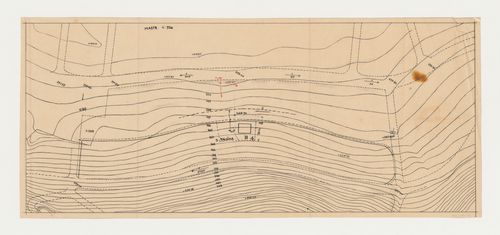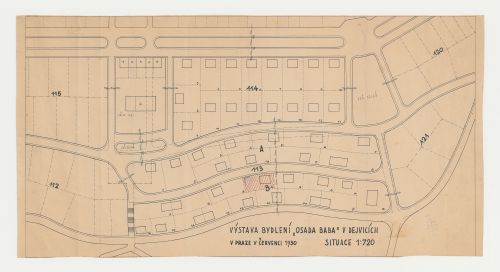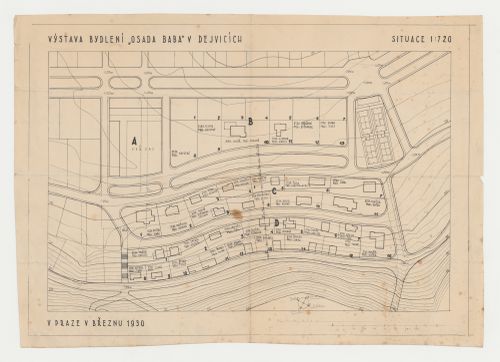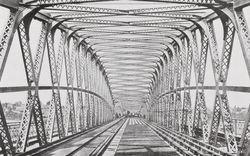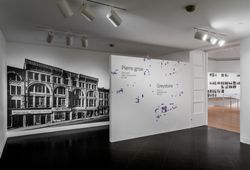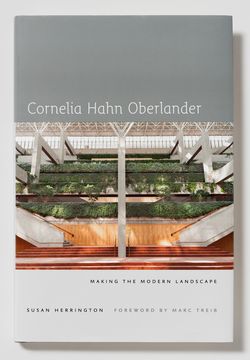DR1984:1338
Description:
- A dotted line in pen and black ink on the topographic survey indicates the lot for Villa Palicka.
architecture, topographique, urbanisme
1928-1932
Topographic survey for Baba Villa Colony showing the lot for Villa Palicka, Prague, Czechoslovakia (now Czech Republic)
Actions:
DR1984:1338
Description:
- A dotted line in pen and black ink on the topographic survey indicates the lot for Villa Palicka.
architecture, topographique, urbanisme
DR1984:1340
Description:
- Hatching in red ink with blue pencil on the site plan indicates the lot for Villa Palicka.
architecture, urbanisme
printed June 1930
Site plan for Baba Villa Colony showing the lot for Villa Palicka, Prague, Czechoslovakia (now Czech Republic)
Actions:
DR1984:1340
Description:
- Hatching in red ink with blue pencil on the site plan indicates the lot for Villa Palicka.
architecture, urbanisme
DR1984:1341
Description:
- Lot numbers and the names of the architects and clients are inscribed on this site plan for Baba Villa Colony, Prague, Czechoslovakia (now Czech Republic) (see object file DR1984:1338 - 1366 for a table by J. Viloria listing lot numbers and the names of the architects and clients).
architecture, urbanisme
printed March 1930
Site plan for Baba Villa Colony, Prague, Czechoslovakia (now Czech Republic)
Actions:
DR1984:1341
Description:
- Lot numbers and the names of the architects and clients are inscribed on this site plan for Baba Villa Colony, Prague, Czechoslovakia (now Czech Republic) (see object file DR1984:1338 - 1366 for a table by J. Viloria listing lot numbers and the names of the architects and clients).
architecture, urbanisme
documents textuels, photographies
Quantité:
7 file(s)
DR1988:0016:001-007
Description:
Part of a miscellaneous group of visual and textual documents collected by Oswald Mathais Ungers, apparently to represent the work of artists/architects in Die gläserne Kette. Consists of memorabelia of Paul Goesch, including 6 photographs and a diploma.
1911
Material from Paul Goesch mostly for Die gläserne Kette
Actions:
DR1988:0016:001-007
Description:
Part of a miscellaneous group of visual and textual documents collected by Oswald Mathais Ungers, apparently to represent the work of artists/architects in Die gläserne Kette. Consists of memorabelia of Paul Goesch, including 6 photographs and a diploma.
documents textuels, photographies
Quantité:
7 file(s)
1911
articles
20th century, A W-Hole House, Boston Road Floor Hole, Bronx Floors, Datum Cut, film, Frances Richard, Gordon Matta-Clark, photographie, photography, Quadrille, Rooftop Atrium, Splitting, Threshole, XXe siècle
12 décembre 2019
archives
Niveau de description archivistique:
Fonds
Joseph Rykwert fonds
AP209
Résumé:
The Joseph Rykwert fonds, 1928-2022, documents Joseph Rykwert’s career as an architectural historian, author and professor. The fonds includes the records for over a dozen monographs written between the mid-1960s and the mid-2010s as well as edited works and articles, and details his teaching and lecturing activities from the 1960s onwards in universities in Europe and the United States. The records highlight Joseph Rykwert’s multidisciplinary approach, which involved archaeology, anthropology and psychoanalysis in his study of the history and theory of architecture and of the urban form. The fonds is composed of textual records, publications and ephemera, and of photographs including multiple albums and a large number of slides; the fonds also documents Joseph Rykwert’s career as an independent designer through drawings realized between the late 1940s and the late 1970s.
1928-2022
Joseph Rykwert fonds
Actions:
AP209
Résumé:
The Joseph Rykwert fonds, 1928-2022, documents Joseph Rykwert’s career as an architectural historian, author and professor. The fonds includes the records for over a dozen monographs written between the mid-1960s and the mid-2010s as well as edited works and articles, and details his teaching and lecturing activities from the 1960s onwards in universities in Europe and the United States. The records highlight Joseph Rykwert’s multidisciplinary approach, which involved archaeology, anthropology and psychoanalysis in his study of the history and theory of architecture and of the urban form. The fonds is composed of textual records, publications and ephemera, and of photographs including multiple albums and a large number of slides; the fonds also documents Joseph Rykwert’s career as an independent designer through drawings realized between the late 1940s and the late 1970s.
archives
Niveau de description archivistique:
Fonds
1928-2022
archives
Niveau de description archivistique:
Fonds
Fonds Peter Eisenman
AP143
Résumé:
The Peter Eisenman fonds documents Eisenman's professional activities as an architect, teacher, and author from the 1950s to 2008. More than 200 projects are represented through conceptual and design development drawings, models, photographs, textual records, and computer-aided drawings. Also well represented in the fonds are materials related to Eisenman's exhibitions, publications, and writings.
1925-2008, predominant 1951-2008
Fonds Peter Eisenman
Actions:
AP143
Résumé:
The Peter Eisenman fonds documents Eisenman's professional activities as an architect, teacher, and author from the 1950s to 2008. More than 200 projects are represented through conceptual and design development drawings, models, photographs, textual records, and computer-aided drawings. Also well represented in the fonds are materials related to Eisenman's exhibitions, publications, and writings.
archives
Niveau de description archivistique:
Fonds
1925-2008, predominant 1951-2008
articles
L’esthétique de l’ingénierie
Désenchantements technologiques
20th century, Alfred Gotthold Meyer, Allemagne, Deutscher Werkbund, engineering, Friedrich Naumann, Germany, ingénierie, Ingenieur-Ästhetik, Joseph August Lux, Karl Marx, Katherine Romba, Munich, Rudolf Metzger, William Morris, XXe siècle
14 octobre 2010
Désenchantements technologiques
Les bâtiments de pierre grise qui se dressent aujourd’hui dans Montréal sont des outils essentiels pour comprendre la ville. Une étude en profondeur de leur histoire matérielle depuis le XVIIe jusqu’au début du XXe siècle démontre comment la géologie, la topographie, les politiques, l’ethnicité, la culture, ainsi que les changements économiques et(...)
Salle octogonale Mot(s)-clé(s):
Greystone, pierre grise, Phyllis Lambert, Montréal, photographie, Richard Pare
13 octobre 2017 au 4 mars 2018
Pierre grise : des outils pour comprendre la ville
Actions:
Description:
Les bâtiments de pierre grise qui se dressent aujourd’hui dans Montréal sont des outils essentiels pour comprendre la ville. Une étude en profondeur de leur histoire matérielle depuis le XVIIe jusqu’au début du XXe siècle démontre comment la géologie, la topographie, les politiques, l’ethnicité, la culture, ainsi que les changements économiques et(...)
Salle octogonale Mot(s)-clé(s):
Greystone, pierre grise, Phyllis Lambert, Montréal, photographie, Richard Pare
Première biographie de l’une des architectes de paysage les plus influentes du XXe siècle, Cornelia Hahn Oberlander: Making the Modern Landscape s’appuie sur des recherches archivistiques, des analyses de sites et de nombreuses entrevues avec Cornelia Oberlander et ses collaborateurs. L’auteure Susan Herrington rencontre Oberlander pour une conversation sur son œuvre et(...)
14 septembre 2014 , 15h
Cornelia Oberlander et Susan Herrington veulent vous parler
Actions:
Description:
Première biographie de l’une des architectes de paysage les plus influentes du XXe siècle, Cornelia Hahn Oberlander: Making the Modern Landscape s’appuie sur des recherches archivistiques, des analyses de sites et de nombreuses entrevues avec Cornelia Oberlander et ses collaborateurs. L’auteure Susan Herrington rencontre Oberlander pour une conversation sur son œuvre et(...)
